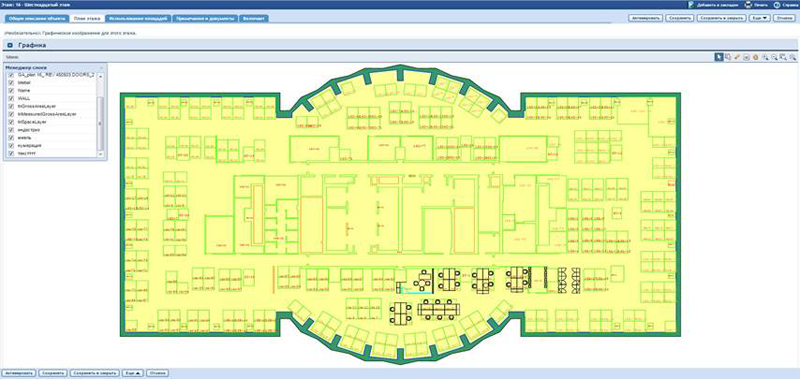6 reasons why real estate automation requires breaking stereotypes
The presence of commercial real estate - a business center, hotel or factory building - implies the existence of management regulations. Well, yes, who does not have the rules? But today we will not talk about his perfection. We will focus on the implementation of these regulations. Alas, in practice, maintenance is not always performed even at 50% of the planned, which leads to significant losses (or costs) on the part of the property owner. This problem needs to be solved with the help of modern automation tools. But introducing them, we must not forget that we work in Russia, and any processes have their own national flavor.

Property management systems are collectively called FM (Facility Management) . And although the abbreviation is English, in Russia such solutions are embodied not quite in the classical form and with other accents. So what advantages do they give to owners or managers? In addition to the general goals of reducing costs and optimizing work that any organization sets itself before, there are some positive aspects of introducing FM systems.
They help to control the deadlines for the execution of applications, taking into account contractual obligations, ensure that maintenance is carried out according to the regulations, availability of real rounds on route cards and at specified intervals, as well as optimize the availability of the required amount of consumables in the warehouse, avoiding excessive stocks. For business, all this is money, and for information systems, information that needs to be properly collected and analyzed.
')
Who performs work on the operation of real estate? These are usually contract organizations. It does not matter whether it is a single company with complex competencies that will attract highly specialized subcontractors, or several operating organizations responsible for different types of work. Even on one fairly large real estate property there is traditionally a mass of confusion associated with the implementation of regulations.
And what does the maintenance of overhaul plans in MS Project and reporting in Excel lead to? Who will be able to figure out where the extra 5 km of pipe, 10 cubes of concrete and the whole football field of a decking board have gone? In the conditions of complete ignorance, management decisions can be made on the basis of non-existent facts, because contractors are tempted to “keep silent” about erroneous actions, tell the customer about the performance of non-existent works and, at the same time, repair a couple of cottages with the office. Therefore, without an automated field control tool, it is difficult.
Example. At one machine-building plant, according to the regulations, rounds of specialized premises had to be performed once a week, about which the contractor reported regularly. When it came to checking, it turned out that MORE THAN YEAR did not enter these premises, putting the work of engineering systems at risk.
In fact, there are not so many systems on the market that are able to provide support for all the FM functionality that Russian companies need today without additional software development. In our practice, we use IBM Maximo and IBM Tririga products. But this does not mean that you can simply install them and use the “accumulated best practices” in order to optimize the management of real estate in the Western style. Alas, in Russia such an approach does not work, however, as in other countries with different traditions of business from the West. A plus in this case is the flexibility of the platform used and the ability to customize it for real customer requirements, as well as a convenient interface for the operator and manager.
See below interface screenshot
Throughout 20 years of work in the direction of FM, we have been convinced that in addition to using market-proven tools, the success of projects is determined by 6 factors that must be considered initially.
 If we take the Western model in its pure form, then the company will have to fully accept the logic of the new information system. This may require changes in the organizational structure, budget items for the operation, corporate reporting formats, and so on. Far from all Russian companies are ready for this, if not to say more - almost no one is ready. Instead of trying to copy someone else's rules, you need to invest in the logic of the system an existing management model, with partial optimization and changes that will help improve the efficiency of operating activities, but will not violate the existing pattern of work.
If we take the Western model in its pure form, then the company will have to fully accept the logic of the new information system. This may require changes in the organizational structure, budget items for the operation, corporate reporting formats, and so on. Far from all Russian companies are ready for this, if not to say more - almost no one is ready. Instead of trying to copy someone else's rules, you need to invest in the logic of the system an existing management model, with partial optimization and changes that will help improve the efficiency of operating activities, but will not violate the existing pattern of work.
 Business users of management systems in the west and in Russia have different approaches to the convenience of the interface. If Western managers strive to optimize system performance, and in many corporations this is a de facto standard, then Russian companies are more successful in projects that help them work more conveniently. Even tender applications often indicate the desire to perform tasks “in less clicks”. Thus, resistance to the introduction of new systems is removed, and tools with an intuitive graphical interface turn out to be preferable.
Business users of management systems in the west and in Russia have different approaches to the convenience of the interface. If Western managers strive to optimize system performance, and in many corporations this is a de facto standard, then Russian companies are more successful in projects that help them work more conveniently. Even tender applications often indicate the desire to perform tasks “in less clicks”. Thus, resistance to the introduction of new systems is removed, and tools with an intuitive graphical interface turn out to be preferable.
 Another very important difference between the existing schemes of property management in different countries is a different subject of control. For example, in the US, many service contracts are tracked at the level of the subject matter of the contract - post-warranty service of refrigerators, regular repair of communications, and so on. In our country, due to the high probability of poor quality of routine procedures, control must be implemented at the level of the works themselves. That is - the inspection of the machine A, the replacement of gaskets in the installation B, and so on.
Another very important difference between the existing schemes of property management in different countries is a different subject of control. For example, in the US, many service contracts are tracked at the level of the subject matter of the contract - post-warranty service of refrigerators, regular repair of communications, and so on. In our country, due to the high probability of poor quality of routine procedures, control must be implemented at the level of the works themselves. That is - the inspection of the machine A, the replacement of gaskets in the installation B, and so on.
 Mobile technology creates an opportunity for a new level of performance control. For example, we created systems in which an employee of a contractor could not report on the crawling of an object without reading RFID tags on the installations themselves, as well as without photos of work performed on the server. You can also use QR tags, but remember - they can be photographed, printed and scanned while sitting at home on the couch.
Mobile technology creates an opportunity for a new level of performance control. For example, we created systems in which an employee of a contractor could not report on the crawling of an object without reading RFID tags on the installations themselves, as well as without photos of work performed on the server. You can also use QR tags, but remember - they can be photographed, printed and scanned while sitting at home on the couch.
 Purchasing materials and taking them into account is a sore subject for many companies. Therefore, integration with budgeting and accounting systems allows you to prevent the waste of corporate funds, as well as to prove the payback of the system to management. If there is a clear understanding of the ratio of money spent, purchased and used materials, the contractor will not be able to build a dacha instead of repairing the basement, overcharge the cost of purchased materials and so on.
Purchasing materials and taking them into account is a sore subject for many companies. Therefore, integration with budgeting and accounting systems allows you to prevent the waste of corporate funds, as well as to prove the payback of the system to management. If there is a clear understanding of the ratio of money spent, purchased and used materials, the contractor will not be able to build a dacha instead of repairing the basement, overcharge the cost of purchased materials and so on.
 Finally, quite often projects for introducing new information systems of the FM class come to a standstill simply because the process control logic does not change. Experience shows that when switching to work in a new automated system, it is necessary to convince managers at all levels to abandon the usual meetings and collective discussions - only by transferring all the processes online you can improve the efficiency of the service organizations.
Finally, quite often projects for introducing new information systems of the FM class come to a standstill simply because the process control logic does not change. Experience shows that when switching to work in a new automated system, it is necessary to convince managers at all levels to abandon the usual meetings and collective discussions - only by transferring all the processes online you can improve the efficiency of the service organizations.
How many will have to go on "new rails?" On average, the introduction of the FM system takes 8-12 months, because the project requires careful preparation. It is necessary to determine the direction of planning, including determining the composition of the monitored indicators and the allowable range of their values. In addition, it is necessary to formalize the organizational structure of the operating unit, the responsibility of individuals, the procedure for the interaction of the system with contractors and the central office. In order for the system to work, it is required to determine the composition of the reporting forms, the rules and the order of their formation, the review procedures and the audit system for the objects. Finally, all this loses its meaning without selected accounting objects with a given degree of cost detail, the order of analyzing historical data and creating graphical representations for making management decisions.
But after the completion of the process, the company receives a tool offering a way to submit valid claims to contractors, to form staff motivation, including through bonuses and generating summary reports for management with the possibility of detailing.
In the following posts we will talk about how such problems were solved at the sites of some Russian customers. Therefore, we ask in the comments to note which aspects of the introduction of FM systems would be the most interesting for you to discuss?





Property management systems are collectively called FM (Facility Management) . And although the abbreviation is English, in Russia such solutions are embodied not quite in the classical form and with other accents. So what advantages do they give to owners or managers? In addition to the general goals of reducing costs and optimizing work that any organization sets itself before, there are some positive aspects of introducing FM systems.
They help to control the deadlines for the execution of applications, taking into account contractual obligations, ensure that maintenance is carried out according to the regulations, availability of real rounds on route cards and at specified intervals, as well as optimize the availability of the required amount of consumables in the warehouse, avoiding excessive stocks. For business, all this is money, and for information systems, information that needs to be properly collected and analyzed.
')
Who performs work on the operation of real estate? These are usually contract organizations. It does not matter whether it is a single company with complex competencies that will attract highly specialized subcontractors, or several operating organizations responsible for different types of work. Even on one fairly large real estate property there is traditionally a mass of confusion associated with the implementation of regulations.
And what does the maintenance of overhaul plans in MS Project and reporting in Excel lead to? Who will be able to figure out where the extra 5 km of pipe, 10 cubes of concrete and the whole football field of a decking board have gone? In the conditions of complete ignorance, management decisions can be made on the basis of non-existent facts, because contractors are tempted to “keep silent” about erroneous actions, tell the customer about the performance of non-existent works and, at the same time, repair a couple of cottages with the office. Therefore, without an automated field control tool, it is difficult.
Example. At one machine-building plant, according to the regulations, rounds of specialized premises had to be performed once a week, about which the contractor reported regularly. When it came to checking, it turned out that MORE THAN YEAR did not enter these premises, putting the work of engineering systems at risk.
In fact, there are not so many systems on the market that are able to provide support for all the FM functionality that Russian companies need today without additional software development. In our practice, we use IBM Maximo and IBM Tririga products. But this does not mean that you can simply install them and use the “accumulated best practices” in order to optimize the management of real estate in the Western style. Alas, in Russia such an approach does not work, however, as in other countries with different traditions of business from the West. A plus in this case is the flexibility of the platform used and the ability to customize it for real customer requirements, as well as a convenient interface for the operator and manager.
See below interface screenshot
The art of property management in Russia
Throughout 20 years of work in the direction of FM, we have been convinced that in addition to using market-proven tools, the success of projects is determined by 6 factors that must be considered initially.
1. Adaptation to existing regulations
 If we take the Western model in its pure form, then the company will have to fully accept the logic of the new information system. This may require changes in the organizational structure, budget items for the operation, corporate reporting formats, and so on. Far from all Russian companies are ready for this, if not to say more - almost no one is ready. Instead of trying to copy someone else's rules, you need to invest in the logic of the system an existing management model, with partial optimization and changes that will help improve the efficiency of operating activities, but will not violate the existing pattern of work.
If we take the Western model in its pure form, then the company will have to fully accept the logic of the new information system. This may require changes in the organizational structure, budget items for the operation, corporate reporting formats, and so on. Far from all Russian companies are ready for this, if not to say more - almost no one is ready. Instead of trying to copy someone else's rules, you need to invest in the logic of the system an existing management model, with partial optimization and changes that will help improve the efficiency of operating activities, but will not violate the existing pattern of work.2. Convenience in priority
 Business users of management systems in the west and in Russia have different approaches to the convenience of the interface. If Western managers strive to optimize system performance, and in many corporations this is a de facto standard, then Russian companies are more successful in projects that help them work more conveniently. Even tender applications often indicate the desire to perform tasks “in less clicks”. Thus, resistance to the introduction of new systems is removed, and tools with an intuitive graphical interface turn out to be preferable.
Business users of management systems in the west and in Russia have different approaches to the convenience of the interface. If Western managers strive to optimize system performance, and in many corporations this is a de facto standard, then Russian companies are more successful in projects that help them work more conveniently. Even tender applications often indicate the desire to perform tasks “in less clicks”. Thus, resistance to the introduction of new systems is removed, and tools with an intuitive graphical interface turn out to be preferable.3. Control at work level
 Another very important difference between the existing schemes of property management in different countries is a different subject of control. For example, in the US, many service contracts are tracked at the level of the subject matter of the contract - post-warranty service of refrigerators, regular repair of communications, and so on. In our country, due to the high probability of poor quality of routine procedures, control must be implemented at the level of the works themselves. That is - the inspection of the machine A, the replacement of gaskets in the installation B, and so on.
Another very important difference between the existing schemes of property management in different countries is a different subject of control. For example, in the US, many service contracts are tracked at the level of the subject matter of the contract - post-warranty service of refrigerators, regular repair of communications, and so on. In our country, due to the high probability of poor quality of routine procedures, control must be implemented at the level of the works themselves. That is - the inspection of the machine A, the replacement of gaskets in the installation B, and so on.4. Use of mobile technology
 Mobile technology creates an opportunity for a new level of performance control. For example, we created systems in which an employee of a contractor could not report on the crawling of an object without reading RFID tags on the installations themselves, as well as without photos of work performed on the server. You can also use QR tags, but remember - they can be photographed, printed and scanned while sitting at home on the couch.
Mobile technology creates an opportunity for a new level of performance control. For example, we created systems in which an employee of a contractor could not report on the crawling of an object without reading RFID tags on the installations themselves, as well as without photos of work performed on the server. You can also use QR tags, but remember - they can be photographed, printed and scanned while sitting at home on the couch.5. Integration with budgeting and accounting systems
 Purchasing materials and taking them into account is a sore subject for many companies. Therefore, integration with budgeting and accounting systems allows you to prevent the waste of corporate funds, as well as to prove the payback of the system to management. If there is a clear understanding of the ratio of money spent, purchased and used materials, the contractor will not be able to build a dacha instead of repairing the basement, overcharge the cost of purchased materials and so on.
Purchasing materials and taking them into account is a sore subject for many companies. Therefore, integration with budgeting and accounting systems allows you to prevent the waste of corporate funds, as well as to prove the payback of the system to management. If there is a clear understanding of the ratio of money spent, purchased and used materials, the contractor will not be able to build a dacha instead of repairing the basement, overcharge the cost of purchased materials and so on.6. Waiver of old decision standards
 Finally, quite often projects for introducing new information systems of the FM class come to a standstill simply because the process control logic does not change. Experience shows that when switching to work in a new automated system, it is necessary to convince managers at all levels to abandon the usual meetings and collective discussions - only by transferring all the processes online you can improve the efficiency of the service organizations.
Finally, quite often projects for introducing new information systems of the FM class come to a standstill simply because the process control logic does not change. Experience shows that when switching to work in a new automated system, it is necessary to convince managers at all levels to abandon the usual meetings and collective discussions - only by transferring all the processes online you can improve the efficiency of the service organizations.Only a year later ...
How many will have to go on "new rails?" On average, the introduction of the FM system takes 8-12 months, because the project requires careful preparation. It is necessary to determine the direction of planning, including determining the composition of the monitored indicators and the allowable range of their values. In addition, it is necessary to formalize the organizational structure of the operating unit, the responsibility of individuals, the procedure for the interaction of the system with contractors and the central office. In order for the system to work, it is required to determine the composition of the reporting forms, the rules and the order of their formation, the review procedures and the audit system for the objects. Finally, all this loses its meaning without selected accounting objects with a given degree of cost detail, the order of analyzing historical data and creating graphical representations for making management decisions.
But after the completion of the process, the company receives a tool offering a way to submit valid claims to contractors, to form staff motivation, including through bonuses and generating summary reports for management with the possibility of detailing.
In the following posts we will talk about how such problems were solved at the sites of some Russian customers. Therefore, we ask in the comments to note which aspects of the introduction of FM systems would be the most interesting for you to discuss?




Source: https://habr.com/ru/post/334748/
All Articles